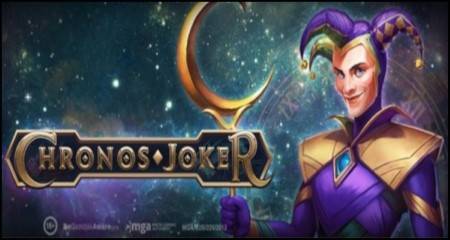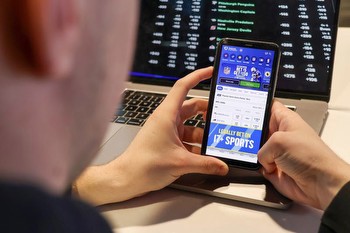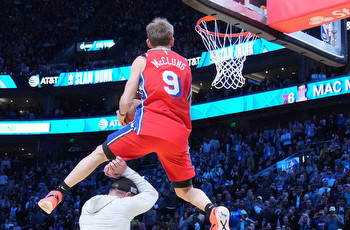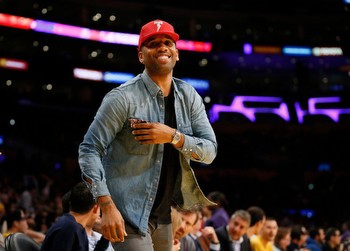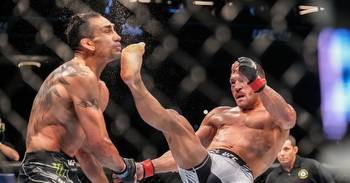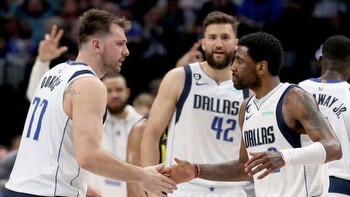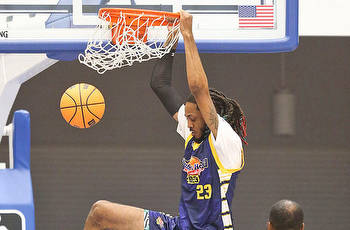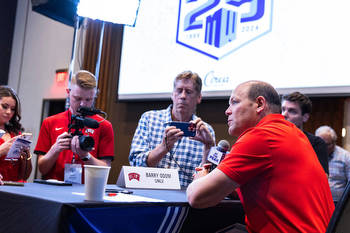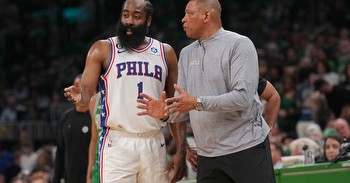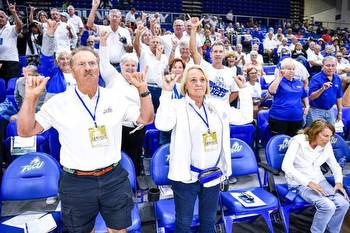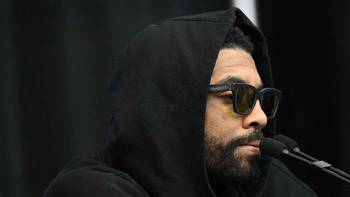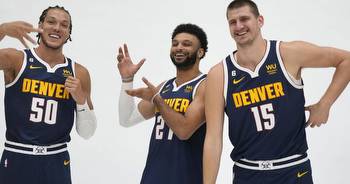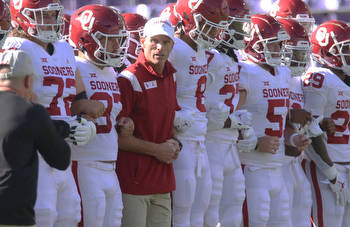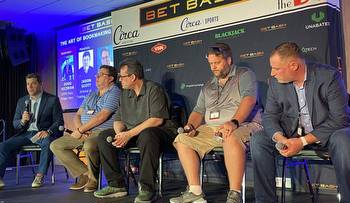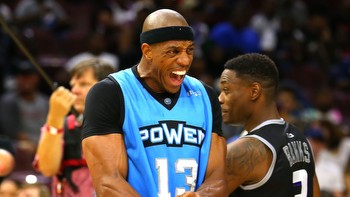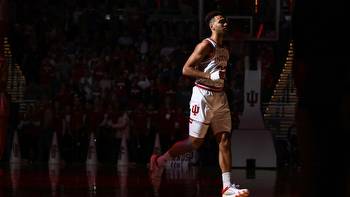SlamBall is back. How can it grow from previous years, and what should fans expect?
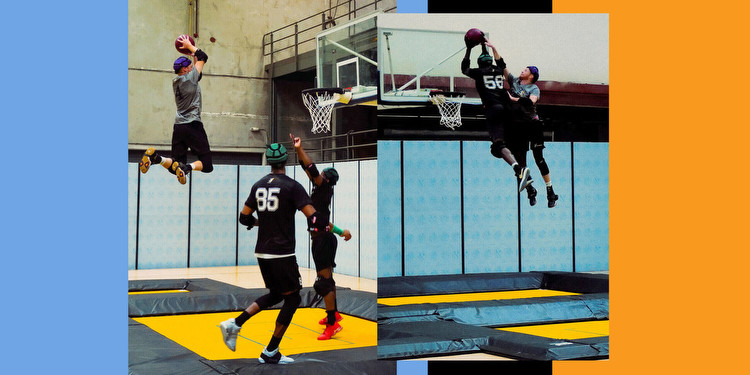
LAS VEGAS — Cam Hollins always knew this day would come. He loved SlamBall growing up in the 2000s and 2010s, scouring YouTube for highlights of athletes soaring through the sky in a way he had never seen before.
SlamBall — the high-energy, heavily intense game, as its website states, “where basketball and football cultures collide,” — had vanished by the time he was an adult, so he joined the Indiana Pacers dunk squad, the Power Pack, to fly off a trampoline during quarter breaks. But he knew the game he loved was still alive somewhere, as old clips suddenly were going viral once again, and the movement to bring back SlamBall was gaining steam.
Once he received news that the sport officially was returning, he knew he was going to end up on its trampoline-covered court. A month later, he was flying around a warehouse off the Las Vegas Strip, wrapping up training camp ahead of his SlamBall debut.
“It was a dream,” Hollins said. “I watched this as a kid, and I told myself when I grow up, I’m gonna do this. And I’m here now, so the manifestation thing is really cool.”
SlamBall 15 years ago seemed to be universally loved, the perfect blend of above-the-rim basketball with the limitless physicality of football. So, where did it go?
“People think SlamBall died, but for me, it never really died when we were done,” SlamBall co-founder Mason Gordon said. “People ask all the time why do you keep at this? Why don’t you just give up on this one? It’s because I’m ludicrously stubborn. I mean, stupid stubborn.
Gordon also mentioned the Teenage Mutant Ninja Turtles as a motivating factor. One of the iconic cartoons of the 1990s first came out as a hyper-violent black-and-white comic book for adults. It had a cult following, but it was too niche to be a commercial success. When it was repurposed as a children’s show, it became a global sensation.
Gordon always believed SlamBall could take off. It just needed to hit at the right time in the right format.
It debuted in 2002 and grew a cult following with its mesmerizing mix of football and basketball played by helmet-wearing players hopping around on courts with trampolines. It was novel, yet violent. After meager ratings in season one, it clocked 2.3 million viewers on its second season’s opening night.
Even as the game fell off in the U.S. in the late 2000s, it found a new life in China in family trampoline centers. Gordon and co-founder Mike Tollin worked with promoters in China to build the sport with world championships in 2012 and 2016, even building training centers on college campuses where students became obsessed with the game.
SlamBall is played over four five-minute periods of full-contact basketball where the idea is to score by any means necessary, launching off four Olympic-sized trampolines that surround each hoop. There are handlers to move the ball (think point guard in basketball), gunners to attack the rim (think slasher or wing), and stoppers to shut down acrobatic dunks (think defensive specialists).
SlamBall’s China expansion eventually ran into the pandemic, and its momentum faltered, but the sport’s popularity on Instagram and TikTok rose simultaneously. Gordon and Tollin knew their moment to strike in the U.S. was near, and after years of their pitch hitting a wall, they suddenly had investors lining up to fund the revival and struck a deal with ESPN to broadcast the eight-team league, as it premiers Friday.
“The internet isn’t interested in anything that’s more than a couple weeks old,” Gordon said. “So, the idea that 20-year-old highlights can have shelf life shows that somewhere along the way, we captured the heart of the internet, and I hope that never changes.”
Gordon brought back his people from the first go-around, hiring the players from the original warehouse where it all started as the coaches and executives running the league today. He wanted to capture the magic of the sport that was still translating while also modernizing it to take advantage of a new era of sports and entertainment.
“The idea that we have that kind of continuity and that I don’t have like, I don’t know, Chris Bosh pretending to coach a SlamBall team here … like, you can’t market that to people authentically,” Gordon said. “People see right through that. But the idea that these are the best SlamBall players and coaches who have ever lived, and they’re here teaching the next generation how to stand up SlamBall to be a global powerhouse sport, that’s the big swing.”
Gordon brought in some of the original players to take on key roles, with Rob Wilson serving as director of player personnel and Stanley Fletcher coaching the Slashers, among others. Gordon also called up Ken Carter, the first SlamBall championship coach who later became known worldwide when Samuel L. Jackson portrayed him in the 2005 film “Coach Carter.”
“I said let me think about it, because I have a school to run and I do a lot of public speaking,” Carter said. “I’m, like, in the top 50 public speakers in the world. Not (a) motivational speaker, I’m an inspirational speaker. When you motivate people, you push from the back. But when you inspire people, you lead from the front.”
Though some of the players descending upon Las Vegas have professional sports experience, this is a life-changing moment for Paxton Henry. A mechanical engineer from Phoenix, Henry didn’t see his athletic career going far beyond his days doing the triple jump at Grand Canyon University. But then his friend Tony Crosby II, a professional dunker who ran track with Henry in college, called him with an opportunity he never could have imagined.
Crosby was being recruited by Wilson and was named to the Special 24, the first group of players brought to Las Vegas for SlamBall training camp. He told Wilson he had to bring in Henry, and after Henry sent over a few clips of his athletic prowess, Henry was booking his flight.
Henry didn’t know what to expect — frankly, nobody did. None of these new players actually had played SlamBall before. But it didn’t take long for him to find his role: trying to be a 3-and-D pest.
“It’s basketball, just extremely aggressive,” Henry said. “Everything at the rim is extreme contact because you’re flying on trampolines.”
He ended up making the cut and was drafted by the Lava, who wanted him to be a floor spacer and take advantage of the new 4-pointer. The new rules have made traditional 3-pointers worth four points, dunks and most midrange shots outside the trampolines worth three, and then layups, floaters and everything else worth just two points. The 5-foot-11 handler — the SlamBall equivalent of a guard — will spend most of his time on the perimeter in this retooled version of the game that will reward deep shooters as much as high-flying dunkers.
But Henry also understands there’s a chance he’s going to be put on a poster at some point.
“We scrimmaged a couple days ago, and I got punched on real bad. That was a whoa moment,” he said. “I’ve dunked in practice and scrimmages. But on that particular faceoff, I thought I got up, but I did not get high enough. My butt was on the rim, but he still soared over me.
“That was when I was like, ‘Damn.’”
When the co-founders were devising how they wanted to bring the game back with a modern twist, they looked to how basketball has evolved to be more of a spread-out game. Though the 3-pointer has taken over, spacing and a higher pace of play have led to posterizations’ becoming almost a nightly occurrence.
“We discussed that exact question about (how) making a 4-point line creates a greater incentive for teams shooting from outside and isn’t that contrary to what SlamBall is all about,” Tollin said. “If it makes (big dunks) more scarce and creates more diversity, maybe that enhances the enjoyment of the game. We’re figuring it out, and each coach has a different answer to that question.”
“Now we have better athletes, and everybody on my team can shoot the basketball,” Carter said. “You’ll be seeing us hit 4-pointers. We’re one of the few teams who actually shoot the 3 and the 4. All the other teams are traditional, but if we have a wide-open shot, we’re taking it.”
Though the coaches and executives from the original iteration have spent the past month training players on the game they built more than 20 years ago, there’s a recognition they are handing the sport over to a new generation of next-level athletes.
“It’s really hard to wrap our minds around where they could actually take SlamBall creatively,” Gordon said. “We’ve showed them just about everything that we were able to do years and years ago on television, and they were, like, ‘OK, I got that. What else you got?’ At some point, we’re going to turn our pockets out, and we’re going to be like, ‘Why don’t you come up with something?’”
Though throwing it down off a trampoline was new for just about everybody, that’s just another day at the office for Hollins. A gunner for MOB, one of the eight teams, Hollins is one of three members from the Pacers’ Power Pack who will be playing in Las Vegas.
“Being out there is my paradise,” Hollins said. “It puts me at peace, and it’s a good way to release some stress, knock some heads off and dunk on some people.”
That’s the bread and butter of this sport: knowing that you can destroy or be destroyed at any moment.
“Everybody here is gonna get dunked on. Everybody here is gonna dunk on somebody,” Henry said. “It really is the highlight sport.”
But the operative word there is “sport.” If SlamBall was going to come back, they didn’t want it to be a fad that would wither away. They want this to be the sport of the summer, then eventually the game of the future.
“The great thing is the coaches aren’t focused on the entertainment value. They’re focused on winning; that’s what’s different about SlamBall 2.0,” Tollin said. “That first time, it was a TV show. Now it’s a sport, and these guys are all about winning.”
While SlamBall is preparing for its reintroduction, its operators and financial backers have already shared an ambitious long-term vision. It is no less audacious than resuscitating an intellectual property that had not made anything new in America in 15 years and expecting it to grow into the next hot sports property.
Roger Ehrenberg, SlamBall’s lead investor and founding partner of Wall Street firm IA Ventures, believes it is a “multibillion-dollar opportunity.” Gordon sees it becoming a pipeline for top players from the leading college basketball and football programs. There already is a plan in place to hold international and domestic events this year, as well as the possibility of creating and selling franchises in the years to come.
“Success is that we’re the UFC of team sports, and we follow that success pathway,” Gordon said. “If the UFC took all these different pugilistic styles and mixed them together into something that was fast, fun and focused on younger demographics, we’re taking the best elements of all these team sports and mixing them together into something that genuinely works and genuinely connects with younger audiences who, by and large, aren’t watching the 2 1/2-hourlong core product of the legacy sports.”
SlamBall already has its next year mapped out. After this initial run in Las Vegas, there will be a tournament in the United States and another abroad by next spring, followed by its second season next summer. That, Gordon and Ehrenberg said, is just the beginning.
Gordon said he wants SlamBall to have tentpole events each year akin to majors. The league will come into a city, set up for seven to 10 days, build buzz through earned media and social media highlights, then have its peak during the playoffs. Then repeat annually.
It is a model he believes could make his league resemble tennis’ ATP Tour.
“We want to establish our Australian Open, our Tokyo Cup, our Italian championships,” he said. “By doing so, we’re gonna globalize the sport in a fraction of the time that legacy sports took to truly become global.”
The other potential step, not yet as clear-cut, is to make teams into franchises, tied to cities. Ehrenberg said there already has been interest, but the league wanted to first nail the actual product and to prove there is a market for it.
There is no shortage of optimism. If SlamBall hits, it will be because the league has re-debuted at the right moment to take advantage of not only its timing on the sports calendar — snug between the NBA and NFL seasons — but also because they think it could be a perfectly bettable sport in the summer.
Ehrenberg hopes that in 2024, SlamBall can be live in several states with microbetting available at each game.
Ehrenberg has coined a term to describe SlamBall’s appeal. He talks about the “entertainmentification of sports,” this combination of live sports and social media, and using sports betting as fodder to build more engagement.
“SlamBall sits at the intersection of literally all of these trends,” he said. “It’s like literally made for TikTok and Insta reels. It’s all about moments.”
It is a sport designed, they said, to appeal to young audiences, neatly packaged into small-time increments and made for an era in which their target viewers are watching less and less live sports and TV.
But there is still the question of whether that audience will watch. It is rudimentary to SlamBall’s success. The first iteration had a staccato five-year run and then lived on mostly in YouTube highlights and social media clips, foundationally relevant to some viewers of that age and ignored by others.
Ehrenberg said he only discovered SlamBall after it was incorporated into an episode of “One Tree Hill,” which he watched only because his two sons did. Their insistence about the league’s potential — the two, now in their mid-20s, served as a makeshift advisory group and voice of the customers he hopes to reach — helped sell Ehrenberg on the sport.
Gordon believes its return in a new format — no longer a TV show filmed, canned and broadcast months apart, but an actual, live sports league — will allow it to blossom.
“It’s a social contract,” Gordon said. “It’s like, hey, listen, if you watch SlamBall for a couple of minutes, you’re gonna see something pretty wild. That’s exactly the social contract that they have with their social media. They’re certainly going to be watching our highlights online.
“And then the question is, are they interested in the core product? We think they will be.”
For the stars of the show, many of them are jumping from relative obscurity to being broadcast across the world. They know that though this is a chance to transform their own lives, they’re also carrying decades of anticipation from SlamBall lifers hoping their sport will catapult onto the big stage.
“We’re about to be on ESPN. It’s different, it’s cool. I’m excited, but we can’t look bad,” Henry said. “There’s going to be millions of people watching us, for real. It’s pressure, but it doesn’t really feel like it.”
Henry will be a small-but-crucial part of making it work. The goal is to build a dedicated fan base that watches the games to appreciate the competition, rather than just marvel at novelty dunks. Going from a TV show to a sport is what can make SlamBall actually survive and thrive.
“Once SlamBall gets into your spirit and your heart, you’re just hooked,” Carter said. “I like the new group of guys that we have in; they’re just absolutely terrific. A lot of these guys didn’t make an NFL or NBA team, and they still get a chance to play professional sports and make a good living. I really believe in five years, SlamBall is gonna be all over the world.”
(Illustration: Ray Orr / The Athletic; photos courtesy of Jared Weiss)
